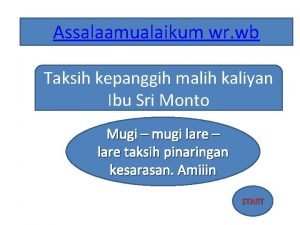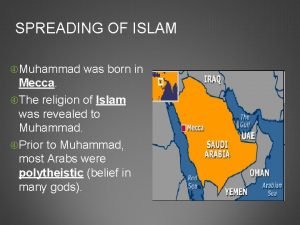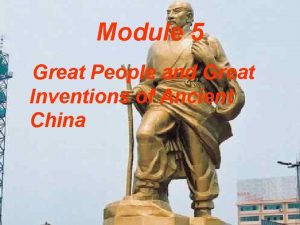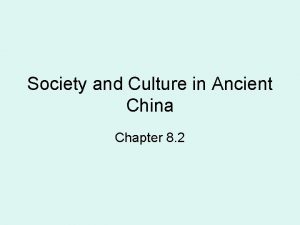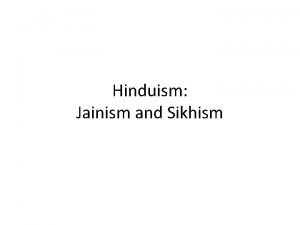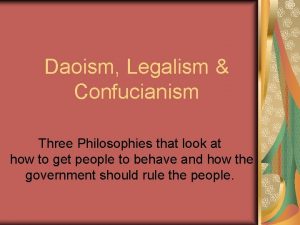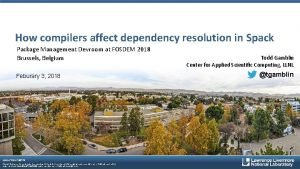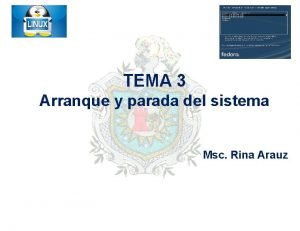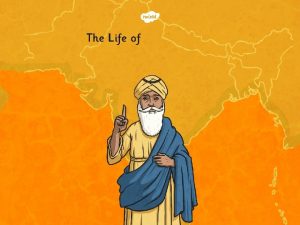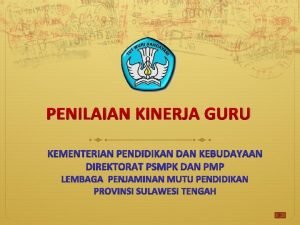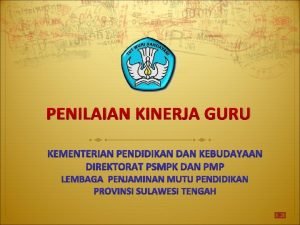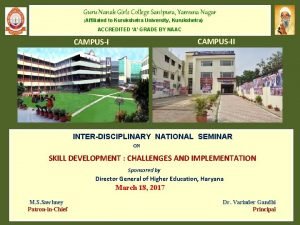GURU NANAK AND HIS TEACHINGS Guru Nanak Dev





































- Slides: 37

GURU NANAK AND HIS TEACHINGS

Guru Nanak Dev Ji was born in a bedi family on the full moon day in 1469. The name of his father was Mehta Kalu and his mother was Tripta Devi. He was married to Sulakhni Devi and two sons were born named Baba Sri Chand Lakhmi Chand. When he attained enlightenment he settled at Kartarpur and started preaching his teachings to the common masses. His main teachings were as follow:

1. Concept of God: According to nanak God is one. He is omnipresent and omnipotent. He is present everywhere. He is bountiful. He is above all. 2. Concept of Guru: He laid stress on the importance of Guru. He believes without guru one can not attain god. Guru is a ladder to reach Guru. 3. Philosophy of Karma: He had full faith in Karma Theory. According to him Soul is Immortal. The Good and Bad actions were determined by Karma of a man. The Karma decide the next birth of human beings. 4. Self Surrender 5. Equality of man. 6. Opposed Caste System. 7. Opposed useless Rituals.

8. He raised voice against women exploitation. 9. Refused to consider Sanskrit language. 10. Opposed priestly class. 11. Emphasis on good conduct of life. 12. Sachkhand 13. Opposed Priestly domination 14. No belief in Asceticism.

DEVELOPMENT OF SIKH INSTITUTIONS

LANGAR: It implies the arrangement of food at the time of religious congregation of Sikhs without their being given anything into return. The most important characteristic of this institution is to provide to the people in rows all the food material – cereals, milk, sugar, fruits and vegetables. MANJI SYSTEM: Sikh Sangat was unable to access the blessings of Guru. So guru divided Punjab into 22 sections i. e. 22 Manjis were established and a chief which was known as Manjidar was appointed.

MASAND SYSTEM: To meet the paucity of funds Guruji started Masand System and Masandis were appointed. They use to collect money from the Sikh followers and submit it to Guruji.

COMPILATION OF ADI GRANTH

The Adi Granth is the most sacred and the authentic book of the Sikhs. It is an important contribution by the fifth Guruji collectd the hyms of first three gurus which was in the Pothi Goindwal. Then he wrote his own banis and compiled it. The compilation was completed in 1604. Guru Nanak had 674 Banis, Guru Angad has 62 Banis, Amardass ji had 907, Ramdass ji had 679, Arjun Dev had 2218. The Hindu saints like Namdev, Kabir, Trilochan, Parmananad, Dhanna, Ramananad, Surdas, Ravidas, Bheekhan, Satta, Mardana.

MARTYRDOM OF GURU ARJUN DEV JI

�CAUSES OF MARTYRDOM: 1. Religious Bigotry of Jahangir. 2. State within State. 3. Opposition of Nakshbandis. 4. Conspiracies of Chandu Shah. 5. Compilation of Adi Granth 6. Opposition of Prithia. 7. Alleged help of Prince Khusro

GURU HARGOBIND NEW POLICY: MIRI PIRI

�Hargobind was the son of the fifth guru i. e. Guru Arjun Dev Causes for the policy: 1. Changing trends in the policy of the Mughal Government. 2. Martyrdom of Guru Arjun Dev. 3. Last message of Guruji 4. Increasing number of Sikh Sangat. 5. Imprisonment of Guru Hargobind. 6. Nature of Sikhism. 7. Desire of Sikhs to free themselves from the tyranny of Mughals.

FEATURES OF POLICY: 1. Wearing of Miri-Piri. 2. Adoption of Royal Symbols. 3. Guru directive to the Sikh Sangat. 4. Change in the daily routine of the Guru. 5. Construction of Akal Takht. 6. Fortification of Amritsar and Construction of Lohgarh. 7. Shelter to the malcontent and fugitives. 8. Encouraged meat-diet and hunting. 9. Congregational Prayers.

MARTYRDOM OF GURU TEG BAHADUR

CAUSES: 1. Religious fanaticism of Aurangzed. 2. Old bitterness between the Sikhs and the Mughals. 3. Impact of Naqsbandis on Aurrangzeb 4. Travels and increasing popularity of Guru Teg Bahadur. 5. Opposition of Ram Rai and Dhir Mal. 6. Prayer of Kashmiri-Pandits.

SIGNIFICANCE: 1. Strengthened the Tradition of Sacrifice. 2. Great resolve of Guru Gobind singh ji 3. Wave of Revenge in the Piunjab. 4. Creation of Khalsa. 5. Downfall of the Mughal Empire.

CREATION OF KHALSA

CAUSES: 1. Need for powerful organisation 2. Aurangzeb Religious Intolerance 3. Coward Hindus 4. Exploitation by the Masands 5. Protection of Dharma. 6. Opposition by the Hill Rajas 7. Impact on Sikh Jats.

PRINCIPLES: 1. 5 K’s (a) Kesh (b) Kangha (c) Kachha (d) Kirpan (e) Kara 2. Believe in oneness of god. 3. Only eat jhatka meat and forbiden to have Halal. 4. Greet everyone with waheguru ji ka Khalsa and Waheguru ji Fateh.

IMPORTANCE: 1. Birth of Martial Race 2. End of Caste discrimination 3. Separate Identity of Sikhism 4. Protection of Hinduism 5. Fulfilling the Mission of Nanak 6. Struggle against Hill Rajas 7. Abolition of Masand System

ESTABLISHMENT OF INDEPENDENT RULE OF BANDA BAHADUR

�Real name: Lachmman Das Battles by Banda: 1. Occupation of Sadhaura 2. Invasion over Sonipat and Kaithal 3. Conquest of Samana and Ghuram 4. Battle of Ropar 5. Battle of Chapar-Chiri 6. Independence of Sikhs in Jalandhar Doab.

UNIFICATION UNDER RANJIT SINGH

�Ranjit singh was the son of sukerchakia Misl chief i. e. Mahan Singh. �Trans-Sutlej Conquest: 1. Conquest of Lahore. 2. Battle of Bhasin 3. Occupation of Akalgarh 4. Conquest of Amritsar. 5. Conquest of Dallawalia 6. Conquest of Kasur 7. Conquest of Sialkot 8. Conquest of Kangra. 9. Conquest of Multan 10. Conquest of Kashmir

ANGLO SIKH RELATION UPTO 1839

�ANGLO SIKH RELATION BETWEEN 1801 -09 �First Contact: Arrival of Yusuf Ali: 1800 � Treaty with the British �Contact of Malwa rulers with Mr. Seton �Metcalfe Mission and the Treaty of Amritsar �Importance of Treaty Amritsar.

ANGLO SIKH RELATION BETWEEN 180939 � Atmosphere of Friendship 1812 -21 �Dispute of Wadni �Friendship again 1826 -28 �Atmosphere of difference and bitterness �Sindh Tangle �Question of Ferozpur �Question of Shikarpur �Tripartite Treaty

FIRST ANGLO SIKH WAR

�CAUSES OF WAR: 1. Expansionist policy of the British 2. Lawlessness and Anarchy in the Punjab 3. British plan to encircle Ranjit Singh Kingdom 4. Dismal Failure of the British in Afganistan 5. Annexation of the Sindh by the British 6. Case of Kaithal 7. Case of Treasurer of Suchet singh 8. War Preparation by the British 9. Anti Sikh Attitude

EVENTS OF THE WAR Battle of Mudki 1845 Battle of Ferozeshah Battle of Baddowal Battle of Aliwal Battle of Sabraon

�Results of the war: First Treaty of Lahore 9 March 1845 Second Treaty of Lahore 11 March 1846 Treaty of Bhairowal 16 Dec 1846

SECOND ANGLO- SIKH WAR ANDTHE ANNEXATION OF PUNJAB

�CAUSES: 1. Imperialistic Policy of the British. 2. Appointment of Lord Dalhousie as the Governor General of India 3. Punjabis were dissatisfied with the Treaties of Lahore 4. Spirit of Revenge among the Sikh Soldiers 5. Mal-Treatment of Lahore Chieftains 6. Harsh Treatment of Maharani Jindan 7. Incidence of Cow-Slaughter 8. Misconduct of the English Soldiers 9. Revolt of Dewan Mulraj 10. Revolt of Sher Singh 11. English Attack and the beginning of war.

�EVENTS: 1. Battle of Ram. Nagar 2. Battle of Chillianwala 3. Success of the British at Multan 4. Battle of Gujarat

RESULTS: 1. End of the Empire of Maharaja Ranjit Singh 2. Punjab annexed to the British Empire 3. Natural Boundary for the British Empire 4. Punishment of Dewan Mulraj and Maharaja Ranjit Singh 5. Crushing of the Nobility

6. Disbanding of Sikh Army 7. Administrative system of the Punjab 8. Peace, Law and order and Prosperity in the Punjab 9. English officers in the Punjab 10. Friendly attitude towards Princely states of the Punjab.
 Sohin mehta
Sohin mehta Gnitc
Gnitc Sree narayana guru teachings
Sree narayana guru teachings Confucius teachings
Confucius teachings Kesh kara kanga kaccha kirpan
Kesh kara kanga kaccha kirpan Isi tembang dhandhanggula pamedhare wasitaning ati
Isi tembang dhandhanggula pamedhare wasitaning ati Sekar pangkur kang winarna tembung sekar nduweni teges
Sekar pangkur kang winarna tembung sekar nduweni teges Geguritan ora kaiket wewaton guru gatra guru wilangan lan
Geguritan ora kaiket wewaton guru gatra guru wilangan lan Four directions teachings
Four directions teachings Taoism vs legalism
Taoism vs legalism Medicine wheel colors and directions
Medicine wheel colors and directions Caritas catholic social teachings
Caritas catholic social teachings Buddhism
Buddhism Confucious values
Confucious values Care for god's creation - catholic social teaching
Care for god's creation - catholic social teaching Hinduism teachings
Hinduism teachings Prior to muhammad’s teachings, arabs were polytheistic.
Prior to muhammad’s teachings, arabs were polytheistic. Teachings of jesus
Teachings of jesus Confucius teachings
Confucius teachings Confucius idea
Confucius idea Teachings of confucius
Teachings of confucius What are the three basic teachings of hinduism
What are the three basic teachings of hinduism If today you are a little better bednar
If today you are a little better bednar Whisol
Whisol What was based on the teachings of a man named mahavira
What was based on the teachings of a man named mahavira Legalism teachings
Legalism teachings Dev and francesca
Dev and francesca Spack dev-build
Spack dev-build Dev sec
Dev sec Pascal criado
Pascal criado Dev strischek
Dev strischek Dev 501
Dev 501 ///remote/fgt_lang?lang=/../../../..//////////dev/
///remote/fgt_lang?lang=/../../../..//////////dev/ La ejecucion de grub install dev sda fallo
La ejecucion de grub install dev sda fallo Sexvalues dev
Sexvalues dev Qconverge console
Qconverge console Practical dev
Practical dev Ibm application development
Ibm application development





